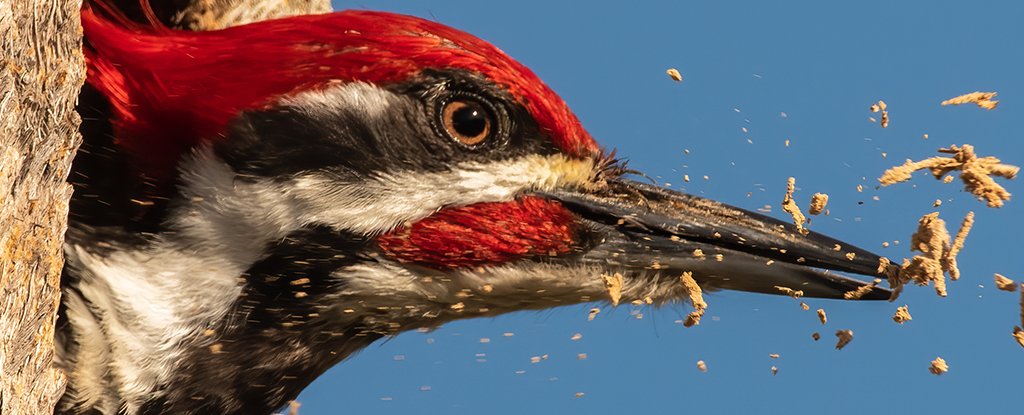Products You May Like
Forced to spend their days slamming their tiny skulls into the sides of trees in search of buried morsels, woodpeckers should have evolved a trick or two to avoid brain damage. So you’d think.
A new study on woodpecker biomechanics has cast doubt on speculations that the small chisel-headed bird avoids turning its brain to mush through fancy shock-absorbing adaptations.
Rather, its brain might simply be too tiny for it to care.
“By analyzing high-speed videos of three species of woodpeckers, we found that woodpeckers do not absorb the shock of the impact with the tree,” says Sam Van Wassenbergh, a biomechanics researcher from the University of Antwerp in Belgium.
Anybody who has ever seen, or even just heard, the machine-gun fire of a woodpecker’s signature tapping would appreciate the physics involved.
Snapping their heads back and forth an astonishing 20 times a second, members of some species can experience forces of up to 1400 g. Compare that with the paltry 90 to 100 g that can give a human concussion, and it’s easy to imagine the kind of trauma that might arise inside that tiny skull.
Past research has pointed to a variety of body modifications that could help lessen the impact on the woodpecker’s brain tissue, such as spongy, shock-absorbing bones and neck muscles.
While these features appear to be engineered to absorb a blow, proving that they successfully reduce the forces as the woodpecker’s head accelerates and decelerates rapidly is a challenge.
There’s also the question of whether woodpeckers even bother with safety features in the first place. Their small brains and tight skulls leave little room for rattling about.
In this study, using more than a hundred high-speed videos of six woodpeckers representing the species Dryocopus martius, Dryocopus pileatus, and Dendrocopos major, Van Wassenbergh and his team carefully measured the deceleration of their eyes as their beaks met wood.
Given the eyeball is a fairly suitable proxy for the squishy insides, the researchers could calculate the physics of a decelerating skull.
It turns out the whole head moves as one, with little variation in peak deceleration between the eye and the beak.
“Their heads basically function as stiff, solid hammers during pecking,” says Van Wassenbergh.
Biomechanical models constructed on data collected from a frame-by-frame analysis of their videos only further verified there wasn’t a great deal of shock-absorption between the tip of the beak and the skull’s contents.
All those specialized bone structures, in which case, don’t so much as deform and absorb energy from each blow as much as resist fracturing.
This makes the birds’ work more impactful and efficient. “If the beak absorbed much of its own impact the unfortunate bird would have to pound even harder,” the researchers explain.
While according to one study the birds may suffer the effects of a lifetime of head-banging, simulations carried out by Van Wassenbergh and his team on the intracranial pressure of the woodpecker’s skull suggest the constant pushing and shoving on such small brains doesn’t amount to anything serious, anyway.
Woodpeckers just don’t need to bother with all those safety features.
“The absence of shock absorption does not mean their brains are in danger during the seemingly violent impacts,” says Van Wassenbergh.
“Even the strongest shocks from the over 100 pecks that were analyzed should still be safe for the woodpeckers’ brains as our calculations showed brain loadings that are lower than that of humans suffering a concussion.”
The findings help explain why woodpeckers never evolved to be much larger than around half a meter (about 22 inches) in length. While a muscly feathered jackhammer could drill out bigger meals, their heavier brains wouldn’t be able to withstand the pressure.
Which means that although they’ve got small brains, woodpeckers aren’t so stupid after all.
This research was published in Current Biology.
